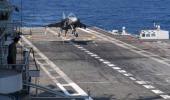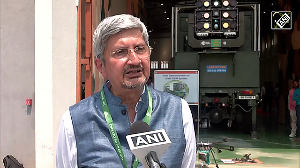On the 20th anniversary of the first flight of the Tejas, we must congratulate the entire team who made sure that the LCA flew and returned safely on January 4, 2001, sowing the seed for development of a state-of-the-art fighter airplane that our country so badly needed, says IAF veteran Air Commodore Nitin Sathe.

A few years ago, on a visit to Bengaluru, I visited the simulator of the Light Combat Aircraft at the Aeronautical Development Agency.
As I stood behind the pilot who was flying the LCA simulator, I could get a sense of being in the air and carrying out complex maneuvers. I also felt the 'g' forces on my body.
As the flight 'landed', out emerged a young man who happened to be an IT professional!
He surprised me by telling me that he hadn't undergone any flight training, but was involved with the development of software being used on the aircraft.
With a lot of cockpit time available to him, he had mastered the art of flying the airplane very well.
January 4, 2021 marked the 20th anniversary of the first flight of the Tejas Light Combat Aircraft, and I couldn't help but remember my first 'simulated' flight on the aircraft, helped, of course, by the IT professional!
Wing Commander Rajeev Kothiyal, who very recently retired from active flying, was the test pilot who took the Tejas Light Combat Aircraft to the skies for the very first time on the morning of January 4, 2001.
Then defence minister George Fernandes, then chief of the air staff Air Chief Marshal Anil Yashwant Tipnis and future President Dr A P J Abdul Kalam were amongst the dignitaries who watched history in the making.
For a new machine to take to the air, one needs to understand that it takes considerable effort and time before it gets off the ground.
From the paper to the working model, the time gaps are huge, technology changes; as do minds and thinking.
So, to freeze a plan and execute the same becomes that much more difficult.
I was speaking just the other day to a seasoned test pilot who flies at HAL Bangalore.
"We test pilots are involved in the project right from the time the project starts on paper." he told me.
"It is the synergy of the scientists who develop the machine, the technicians who build it and the pilots who eventually fly it along with scores of other people in the loop who are responsible for the project," the etst pilot added.
"We first have a technology demonstrator (TD) which is just the basic aircraft; this is followed by the limited series production (LSP), which, after extensive testing and trials is handed over to the user (the IAF in this case) for the IOC and the FOC (the initial operational clearance and the final operational clearance)," he explained.
Through all these stages, the aircraft keeps getting better and better with inputs provided by those who fly it in various simulated missions.
That's how we got the Tejas Mark 1, Mark 1A, Mark 2 etc, with each series of modifications.
Although there isn't any laid down limit for development of an aircraft, it may be fair to say that it could safely take a decade or so for any new design on paper to become a fighting/operational aircraft in the Indian Air Force.

The Tejas, however has taken much more.
I was going through a book by a dear friend Group Captain Rajiv Kumar Narang, India's Quest for UAVs and Challenges', published in 2019.
Rajiv writes that the LCA development history shows how aeronautics research, design and development never received due significance in our national priorities.
After the HF-24 programme was discontinued, for almost two decades, there was no fighter programme on the anvil which led to a break in passing down the legacy and knowhow to future generations of designers.
In his book, Rajiv writes, 'There has been inconsistency and incoherence in aerospace designs in India. Inconsistency in pursuing domestic aeronautics programmes and incoherence among stakeholders have been the two key limiting factors affecting domestic aeronautics projects.'
'This aspect can be better understood by comparing Space, Atomic Energy and Aeronautics programmes. While the Space and Atomic Energy programmes achieved a fair degree of success due to the nation's full commitment by establishing the Space and Aeronautics Commission, the requirement of an Aeronautics Commission is still far away.'
We need to have better synergy amongst the various stakeholders involved in the production of such high-end technology.
It is the only way to speed up development projects and achieve self-reliance at the earliest.
I asked my friend at HAL how one feels while getting a new plane off the ground.
"Yes, there are butterflies in the stomach. But since we have been with the project right from the inception stage, we are quite comfortable in our minds that things will work for which they have been designed."
"Also is the fact that a whole lot of simulation is carried out and data generated gives the pilots a fair idea of what to expect."
In the case of the Tejas, the simulator was available for the pilots to get familiar with the insides of the cockpit and also practise emergency drills.
"This along with the training we receive at the Test Pilots School makes us competent to take to the air in a brand new designed airplane with a fair degree of confidence and achieve success," says the test pilot.
On the 20th anniversary of the first flight of the Tejas, we must congratulate the entire team of men and women -- past and present-- who made sure that the LCA flew and returned safely on January 4, 2001, thus, sowing the seed for development of the state-of-the-art fighter airplane that our country so badly needed.
Air Commodore Nitin Sathe retired from the Indian Air Force in February 2020 after a distinguished 35 year career.
The author of three books, you can read Air Commodore Sathe's earlier contributions here.
Feature Presentation: Ashish Narsale/ Rediff.com












 © 2025
© 2025